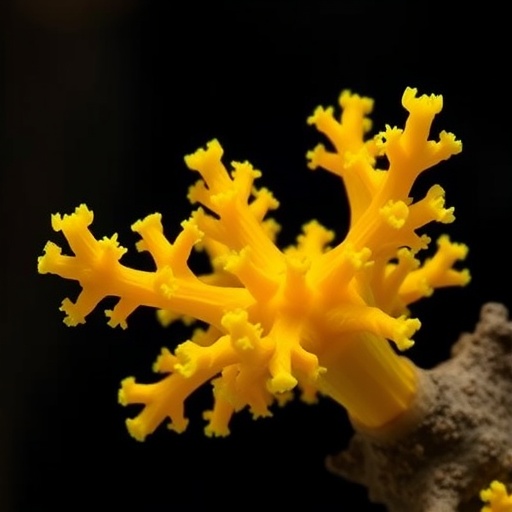In an intriguing exploration into the untapped realms of fungal biosynthesis, researchers have embarked on a journey to activate silent biosynthetic gene clusters (BGCs) within fungal strains. Their quest has led to the discovery of novel natural compounds, with a particular focus on the fungus Talaromyces sp. KTF-0021, a mutant strain derived from the FKI-5759 lineage, genetically modified via the introduction of the laeA gene. This innovative approach allows for a remarkable increase in the production of secondary metabolites, drawing the attention of researchers who aim to unearth previously hidden compounds that may hold significant pharmacological potential.
Among the notable findings from this research is the identification of a new benzoyl sesquiterpenoid compound known as aoganolide. This compound, classified as 4 in their research, presents as a key highlight, showcasing the power of genetic manipulation in the discovery of unique natural products. During extensive spectroscopic analysis, the planar structure of aoganolide was elucidated, adding to the scientific understanding of its molecular architecture. The absolute configuration of aoganolide further underscores the complexity of its structure, as it was determined using the sophisticated computed electronic circular dichroism (ECD) spectral method, a powerful tool for analyzing chiral molecules.
In addition to aoganolide, the researchers reported the successful isolation of three known compounds: decarboxyaltenusin, altenusin, and penipyranicin B. Each of these compounds has been previously documented, yet their presence in the cultured broth of Talaromyces sp. KTF-0021 contributes valuable insight into the metabolic capabilities of this particular strain. The presence of multiple bioactive compounds in conjunction with aoganolide suggests a rich biosynthetic landscape that may lead to future discoveries of significance within the field of natural product chemistry and pharmacology.
The experimental results derived from Talaromyces sp. KTF-0021 yielded impressive productivity metrics for the identified compounds. Aoganolide, decarboxyaltenusin, altenusin, and penipyranicin B were produced in significantly higher quantities in the laeA-introduced mutant strain compared to the wild-type counterpart. Specifically, the mutant strain produced 47 mg/L of decarboxyaltenusin, 623 mg/L of altenusin, and 38 mg/L of aoganolide. In contrast, their wild-type variant produced only 1.4 mg/L of decarboxyaltenusin, 0.8 mg/L of altenusin, and 7.7 mg/L of aoganolide. This stark contrast in yields not only validates the efficacy of the laeA modification but also highlights the exceptional potential of utilizing genetic techniques to explore and expand the chemical diversity found within fungal species.
The pharmacological assessment of aoganolide unveiled its compelling antimalarial properties, showcasing IC50 values of 4.37 µg/ml and 6.46 µg/ml against the malarial strains Plasmodium falciparum FCR3 and K1, respectively. Such findings are not only of academic interest but could translate into vital therapeutic avenues in the treatment of malaria, a disease that continues to affect millions globally. The unique structure of aoganolide, along with its demonstrated biological activity, positions it as an attractive candidate for further study and potential drug development.
Moreover, the findings of this research open doors to the broader implications of manipulating genetic elements within microorganisms to reveal hidden biosynthetic potential. The ability to enhance the yield of valuable natural products has profound implications for the pharmaceutical and biotechnological industries, particularly as the demand for novel therapeutic agents continues to rise in the face of drug resistance and emerging diseases. Fungi, often overlooked in the quest for new drugs, may well hold the key to discovering the next generation of bioactive compounds.
The interdisciplinary nature of this study combines elements of microbiology, genetics, and chemistry, highlighting the importance of collaborative research approaches in understanding and harnessing the capabilities of microorganisms. As scientists continue to decode the biochemical pathways involved in secondary metabolite production, the landscape of potential natural products will expand, possibly leading to breakthroughs in various fields, including medicine, agriculture, and industry.
This research not only underscores the importance of laeA gene manipulation in fostering new biosynthetic activities but also provides a blueprint for other researchers aiming to explore the depths of fungal genetics and secondary metabolism. As the scientific community becomes increasingly aware of the potential that lies within unexplored fungal species, it may inspire a new wave of discovery that could enrich the medicinal toolbox available to combat infectious diseases.
The findings serve as a clarion call to the scientific community to invest in the exploration of genetic strategies as avenues for enhancing the biosynthetic capabilities of microorganisms. Continued research in this field could not only amplify the production of known compounds but encourage the discovery of novel entities that have yet to be characterized, ultimately enriching the repository of bioactive natural products essential for human health.
In conclusion, the isolation of aoganolide and other compounds from the Talaromyces sp. KTF-0021 mutant strain exemplifies the fruitful intersection of genetics and natural products chemistry. For researchers and pharmacologists alike, the implications of this work are profound, providing new strategies for enhancing the production of valuable compounds that hold promise for therapeutic development. As we stride into an age where the manipulation of microbial genetics becomes commonplace, the exciting discoveries stemming from this research position us on the brink of significant advancements in the fight against diseases.
Subject of Research: Activation of silent biosynthetic gene clusters in fungi to discover novel natural compounds.
Article Title: New benzoyl sesquiterpenoid, aoganolide, produced by Talaromyces sp. KTF-0021 strain (laeA-introduced mutant of FKI-5759 strain).
Article References:
Hamada, K., Watanabe, Y., Kikuchi, Y. et al. New benzoyl sesquiterpenoid, aoganolide, produced by Talaromyces sp. KTF-0021 strain (laeA-introduced mutant of FKI-5759 strain).
J Antibiot 78, 586–592 (2025). https://doi.org/10.1038/s41429-025-00851-6
Image Credits: AI Generated
DOI: September 2025
Keywords: fungal biosynthesis, natural products, aoganolide, Talaromyces, secondary metabolites, antimalarial activity.
Tags: aoganolide compound characterizationBenzoyl sesquiterpenoid discoveryelectronic circular dichroism methodfungal biosynthesis researchgenetic modification in fungiinnovative approaches in mycologynatural compounds from fungipharmacological potential of natural productssecondary metabolites in fungisilent biosynthetic gene clustersspectroscopic analysis of natural productsTalaromyces sp. KTF-0021





